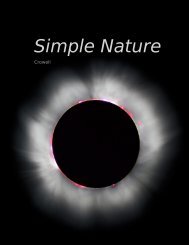Chapter 3 Acceleration and free fall - Light and Matter
Chapter 3 Acceleration and free fall - Light and Matter
Chapter 3 Acceleration and free fall - Light and Matter
You also want an ePaper? Increase the reach of your titles
YUMPU automatically turns print PDFs into web optimized ePapers that Google loves.
106 <strong>Chapter</strong> 3 <strong>Acceleration</strong> <strong>and</strong> <strong>free</strong> <strong>fall</strong><br />
The solution is incorrect because you can’t find the slope of a<br />
graph from one point. This person was just using the point at the<br />
right end of the v-t graph to try to find the slope of the curve.<br />
Incorrect solution #2: Velocity is distance divided by time so v =<br />
(4.5 m)/(3 s) = 1.5 m/s. <strong>Acceleration</strong> is velocity divided by time,<br />
so a = (1.5 m/s)/(3 s) = 0.5 m/s 2 .<br />
The solution is incorrect because velocity is the slope of the<br />
tangent line. In a case like this where the velocity is changing,<br />
you can’t just pick two points on the x-t graph <strong>and</strong> use them to<br />
find the velocity.<br />
Converting g to different units example 3<br />
⊲ What is g in units of cm/s 2 ?<br />
⊲ The answer is going to be how many cm/s of speed a <strong>fall</strong>ing<br />
object gains in one second. If it gains 9.8 m/s in one second, then<br />
it gains 980 cm/s in one second, so g = 980 cm/s 2 . Alternatively,<br />
we can use the method of fractions that equal one:<br />
9.8 ✚m<br />
s 2<br />
100 cm 980 cm<br />
× =<br />
1 ✚m s2 ⊲ What is g in units of miles/hour 2 ?<br />
⊲<br />
9.8 m<br />
s2 1 mile<br />
×<br />
1600 m ×<br />
� �2 3600 s<br />
= 7.9 × 10<br />
1 hour<br />
4 mile/hour 2<br />
This large number can be interpreted as the speed, in miles per<br />
hour, that you would gain by <strong>fall</strong>ing for one hour. Note that we had<br />
to square the conversion factor of 3600 s/hour in order to cancel<br />
out the units of seconds squared in the denominator.<br />
⊲ What is g in units of miles/hour/s?<br />
⊲<br />
9.8 m<br />
s2 1 mile 3600 s<br />
× × = 22 mile/hour/s<br />
1600 m 1 hour<br />
This is a figure that Americans will have an intuitive feel for. If<br />
your car has a forward acceleration equal to the acceleration of a<br />
<strong>fall</strong>ing object, then you will gain 22 miles per hour of speed every<br />
second. However, using mixed time units of hours <strong>and</strong> seconds<br />
like this is usually inconvenient for problem-solving. It would be<br />
like using units of foot-inches for area instead of ft 2 or in 2 .<br />
The acceleration of gravity is different in different locations.<br />
Everyone knows that gravity is weaker on the moon, but actually<br />
it is not even the same everywhere on Earth, as shown by the<br />
sampling of numerical data in the following table.














